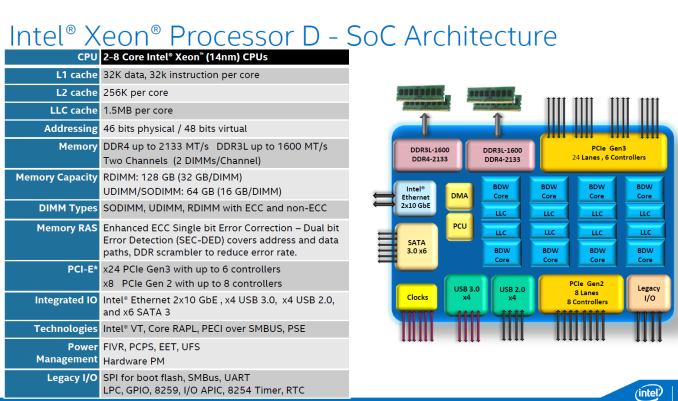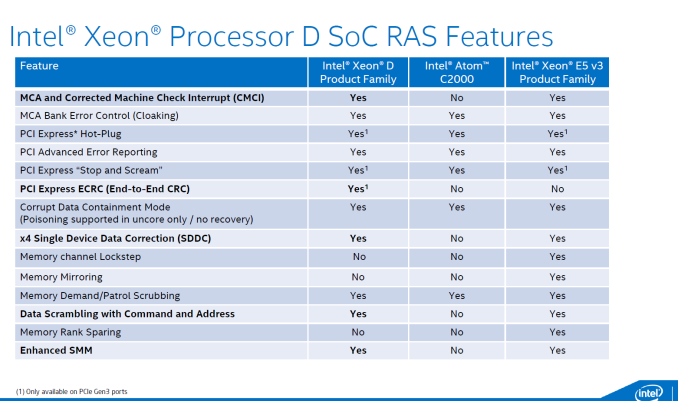The Intel Xeon D Review: Performance Per Watt Server SoC Champion?
by Johan De Gelas on June 23, 2015 8:35 AM EST- Posted in
- CPUs
- Intel
- Xeon-D
- Broadwell-DE
Broadwell in a Server SoC
In a nutshell, the Xeon D-1540 is two silicon dies in one highly integrated package. Eight 14 nm Broadwell cores, a shared L3-cache, a dual 10 gigabit MAC, a PCIe 3.0 root with 24 lanes find a home in the integrated SoC whereas in the same package we find four USB 3.0, four USB 2.0, six SATA3 controllers and a PCIe 2.0 root integrated in a PCH chip.
The Broadwell architecture brings small microarchitectural improvements - Intel currently claims about 5.5% higher IPC in integer processing. Other improvements include slightly lower VM exit/enter latencies, something that Intel has been improving with almost every recent generation (excluding Sandy Bridge).
Of course, if you are in the server business, you care little about all the small IPC improvements. Let us focus on the large relevant improvements. The big improvements over the Xeon E3-1200 v3 are:
- Twice as many cores and threads (8/16 vs 4/8)
- 32 GB instead of 8 GB per DIMM supported and support for DDR4-2133
- Maximum memory capacity has quadrupled (128 GB vs 32 GB)
- 24 PCIe 3.0 lanes instead of 16 PCIe 3.0 lanes
- 12 MB L3 rather than 8 MB L3
- No separate C22x chipset necessary for SATA / USB
- Dual 10 Gbit Ethernet integrated ...
And last but not least, RAS (Reliability, Availability and Servicability) features which are more similar to the Xeon E5:
The only RAS features missing in the Xeon D are the expensive ones like memory mirroring. Those RAS features a very rarely used, and The Xeon D can not offer them as it does not have a second memory controller.
Compared to the Atom C2000, the biggest improvement is the fact that the Broadwell core is vastly more advanced than the Silvermont core. That is not all:
- Atom C2000 had no L3-cache, and are thus a lot slower in situation where the cores have to sync a lot (databases)
- No support for USB 3 (Xeon D: four USB 3 controllers)
- As far as we know Atom C2000 server boards were limited to two 1 Gbit PHYs (unless you add a separate 10 GBe controller)
- No support for PCIe 3.0, "only" 16 PCIe Gen2 lanes.
There are more subtle differences of course such as using a crossbar rather than a ring, but those are beyond the scope of this review.













90 Comments
View All Comments
AkulaClass - Tuesday, June 23, 2015 - link
Nice stuff. Realy good to see them bringing power consumption down pr. Performance.WorldWithoutMadness - Tuesday, June 23, 2015 - link
Nice way to confuse people. Codename Yosemiteretrospooty - Tuesday, June 23, 2015 - link
Who would this confuse? Apple fans because of the OS witht he same codename?LOL. Believe me they don't know, or care... Most of them aren't even aware of what a "server" chip is, or even what a "server" is used for.
IanHagen - Tuesday, June 23, 2015 - link
Rails developer checking in to remind you that a great chunk of the Rails community develop using OS X to deploy on Linux and hence is aware of "server chips". Even though you said that "most" Apple users don't know what a server chip is and that's accurate, the same could be said about Windows or even Linux common users. Stop patronizing.All being said, I agree with you. Who could possibly confound the Xeon D's codename coincides with OS X's 10.10 name?
WinterCharm - Tuesday, June 23, 2015 - link
First of all, your implication that apple fans don't know jack shit about servers is a broad generalization, and a stupid one at that.Second of all, anyone who knows enough to even consider buying a Xeon and a motherboard that supports it and the ECC memory, probably knows enough to not get confused. And plenty of mac users know what server chips are and what they're used for.
Nice trolling though.
adithyay328 - Tuesday, August 25, 2015 - link
That's not entirely true, but I will agree that people a lot of the people who use Apples( No discrimination intended) only continue to use Apple due to their lack of tech knowledge( like knowing Android is the king :) . And, yes, they probably won;t know what servers even are.jeffsci - Monday, June 29, 2015 - link
Geographic code names are the norm in the computing industry (I think because they cannot be copyrighted) and they end up being reused. For example, Intel Seattle is/was a motherboard and AMD Seattle is/was an ARM64 processor. See https://en.wikipedia.org/wiki/List_of_Intel_codena... https://en.wikipedia.org/wiki/List_of_Microsoft_co... etc. if you would like to look for more examples :-)RaiderJ - Tuesday, June 23, 2015 - link
Any places in the US that the motherboard is available for purchase? Quick checks looks like it's mostly sold out or otherwise unavailable?ats - Tuesday, June 23, 2015 - link
Availability comes and goes. Xeon D has been a big hit in the large scale deployment markets and they've been soaking up a lot of demand for it, both bare and combined on motherboards like the supermicro offerings severely limiting retail availability. But it is available in retail but quantities are limited. Quite a number of people over at servethehome have gotten their hands on them. If you want one, you'll likely have to keep checking the major sites like newegg, amazon, et al for them to come back in stock. Retail boards are generally in the $800-1000 range atm (basically going for full list but then again bare motherboards with 10gbe tend to go for 600+ so its still a good buy and simple new 10gbe cards tend to go for $300-500).ToTTenTranz - Tuesday, June 23, 2015 - link
How come they call this a SoC if there's no integrated module to drive even a simple display, and they apparently need a discrete PCIe graphics card for that D-SUB output?